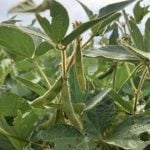If this year’s wheat crop develops an orange tinge, farmers could be dealing with a stripe rust infection.
Kelly Turkington, a plant pathologist with Agriculture Canada in Lacombe, Alta., said stripe rust is a concern in Western Canada.
“It seems to be increasing in incidence and severity over the last five to 10 years,” Turkington said.
“There are some pretty susceptible varieties out there and that may be part of the problem.”
Brent McCallum, a rust pathologist with Agriculture Canada’s cereal research centre in Winnipeg, has been doing annual western Canadian rust surveys.
Read Also

VIDEO: Green Lightning and Nytro Ag win sustainability innovation award
Nytro Ag Corp and Green Lightning recieved an innovation award at Ag in Motion 2025 for the Green Lightning Nitrogen Machine, which converts atmospheric nitrogen into a plant-usable form.
“In 2005, there was a pretty bad epidemic of stripe rust in Alberta, but not so bad in Manitoba and Saskatchewan,” he said.
“This year, we’re certainly on the lookout for stripe rust. A lot of our inoculum comes in from the south, but it depends a lot on weather conditions and what kind of environment we have for the stripe rust to develop. So it’s hard to estimate until you get into the season and see the progression of the disease.”
McCallum said rust is an ongoing concern in the Pacific Northwest region of the United States Ð especially Washington state – and in southern Alberta.
“We’ll have stripe rust in that area pretty much every year. It just depends on the severity. In some years it’s worse than others. But in the central parts of the Prairies, from Texas up to Manitoba and Saskatchewan, we really never saw stripe rust until about 2000,” he said.
“That year we started to see stripe rust in Manitoba and Saskatchewan, and they were getting pretty bad epidemics in the southern U.S., through Texas and Arkansas. Those were areas where they never saw stripe rust and they were getting pretty bad epidemics from 2000 up to 2005.”
Jack Riesselman, a plant pathologist with Montana State University in Bozeman, Montana, said the disease was once considered a problem only in intermountain regions and along the front range of the Rocky Mountains.
However, in recent years, the predominant race of stripe rust fungus has become more heat tolerant and has spread across Montana and into adjacent states.
“Reports this spring suggest that stripe rust has over-wintered along the east side of the Rockies. Washington, Oregon and northern California are all reporting early high levels of stripe rust,” said Riesselman.
In Western Canada, the fungus normally comes in with winds from the Pacific Northwest. Now there’s a concern that it’s maybe overwintering in Alberta due to mild winters.
Turkington said producers in southern Alberta and west-central Saskatchewan should watch for significant winds originating from the U.S.
“You can check websites in the U.S. that provide updates on rust development in general, including stripe rust. But the important thing is to scout your fields,” Turkington said.
“Often when we get called out to a field it’s too late to do anything. And in some cases, it’s come into the crop so late that even if you don’t spray, it won’t have a significant impact on yield.”
Like most rusts, stripe rust can be explosive and can move into a crop quickly given favourable conditions.
If it is visible in the middle part of the canopy and it hasn’t progressed into the upper leaf, spraying might be useful.
Turkington said stripe rust normally doesn’t appear until the first or second week of August and by that time it’s more of a curiosity. It doesn’t have a huge impact on yield but in the last five years, it has been appearing in crops earlier than expected.
McCallum said timing of the disease depends on the crop.
“We get a little bit of overwintering of stripe rust on winter wheat, but it tends not to be very severe. In Manitoba, we see stripe rust in early July. It’s a cool season type of rust. When it gets too hot it sort of shuts down.”
“(In Manitoba) in late July and early August, it gets quite hot. That protects us from stripe rust. But in Alberta, you’ve got cooler conditions, so it proliferates longer through the season,” he said.
According to Turkington, spraying a wheat crop with a fungicide for other diseases could also help control stripe rust.
“At the time of flag leaf emergence, the focus of the fungicide is to protect the green leaf area from whatever might be there, whether its tan spot, septoria or other diseases,” he said.
McCallum said the most commonly used fungicides used on wheat in Manitoba include Tilt and Folicur.
“I think most of the fungicides work pretty well on the rust. In Manitoba they’re spraying primarily for fusarium head blight control, but they get good control of the rusts with the fungicides they’re using.”
Turkington said that while the most common infection site is the leaf, stripe rust can also attack the heads.
“If you look at them from five to 10 feet away, you’d swear they were fusarium head blight symptoms.”
He said many producers and industry called last summer concerned about head blight symptoms.
“We’ve gone into the field and said, ‘You don’t have head blight, you’ve got stripe rust.’ It bleaches the infected parts of the head, which is similar to head blight. But it produces these orangey yellowish spore masses, which are very granular.”
Possibly the most susceptible situation for stripe rust infection is when farmers seed wheat for swath grazing.
“They’ll seed it quite late in the season and it’s just starting its main vegetative growth when everything else is starting to senesce off. The inoculum is built up, so it moves onto these later seeded crops and it can be quite spectacular. You walk through the crop and you’re covered in orangeish yellowish spores,” said Turkington.
The pathologist said that while all wheat classes can get stripe rust, varieties within each class have different levels of susceptibility.
“It does vary on cultivars. We did some tests of spring wheat cultivars for stripe rust, over a couple of years, in areas where they have stripe rust problems. We don’t have anything that’s completely resistant, but we do have varieties that are partially resistant. Then there’s other varieties that are more fully susceptible.”
In Alberta, rusts are usually a non-issue. But with stripe rust, something unusual seems to be happening, he said.
“It may be a gradual shift in the varieties we’re using becoming more susceptible, it may be mild winters allowing the pathogens to overwinter, or we’ve had a sequence of years we’ve had wind events that have brought the pathogen up to southern and central Alberta.”














